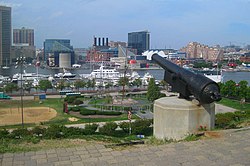Federal Hill, Baltimore
|
Federal Hill Historic District
|
|

Federal Hill Park
|
|
| Location | Bounded by Baltimore Harbor, Hughes, Hanover, and Cross Sts., Baltimore, Maryland |
|---|---|
| Coordinates | 39°16′44″N 76°36′36″W / 39.27889°N 76.61000°WCoordinates: 39°16′44″N 76°36′36″W / 39.27889°N 76.61000°W |
| Built | 1780 |
| Architect | Multiple |
| Architectural style | Greek Revival, Federal |
| NRHP Reference # | |
|
Federal Hill South Historic District
|
|
| Location | Roughly bounded by Cross St., Olive St., Marshall St., Ostend St., Fort Ave. and Covington St., Baltimore, Maryland |
| Coordinates | 39°16′33″N 76°36′39″W / 39.27583°N 76.61083°W |
| Area | 70 acres (28 ha) |
| Built | 1830 |
| Architect | Jackson Gott and others |
| Architectural style | Federal, Mid 19th Century Revival |
| NRHP Reference # | 03001331 |
| Added to NRHP | December 22, 2003 |
| Added to NRHP | April 17, 1970 |
Federal Hill is a neighborhood in Baltimore, Maryland, United States that lies just to the south of the city's central business district. Many of the structures are included in the Federal Hill Historic District, listed on the National Register of Historic Places in 1970. Other structures are included in the Federal Hill South Historic District, listed in 2003.
The neighborhood is named for the prominent hill that is easily viewed from the Inner Harbor area, to which the neighborhood forms the physical south boundary. The hillside is a lush green and serves as a community park. The neighborhood occupies the northwestern part of a peninsula that extends along two branches of the Patapsco River—the Northwest Branch (ending at the Inner Harbor) and the Middle Branch. This peninsula is generally referred to as the South Baltimore Peninsula, and includes the neighborhoods of Federal Hill, Locust Point, Riverside, South Baltimore, and Sharp-Leadenhall. While not physically a part of the peninsula, Otterbein is also included in the collection of neighborhoods which make up greater South Baltimore. Traditionally, Federal Hill was roughly triangular, bordered by Hanover Street to the west; Hughes Street, the harbor, and Key Highway to the north and east; and Cross Street to the south.
The Cross Street Market, a historic marketplace built in the 19th century, continues to serve residents and is the primary social and commercial hub for the neighborhood. As of late 2016, the City of Baltimore has entered into an agreement with Caves Valley Partners to renovate Cross Street Market. The multi-million dollar rebuild is anticipated to break ground during Spring 2017.
The primary business district is bounded by Montgomery, Ostend, Light, Charles and Hanover Streets, and is home to a large number of restaurants of a wide range of taste, quality, and price, and many small shops as well as a few larger, more practical stores. The neighborhood is a popular destination for tavern goers and music lovers, with street festivals several times a year. These are organized through a very active neighborhood organization and business organization, as is the annual Shakespeare on the Hill series of summer performances in the park atop the actual Federal Hill. The neighborhood is also home to the American Visionary Art Museum and Maryland Science Center.
...
Wikipedia



